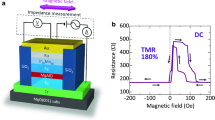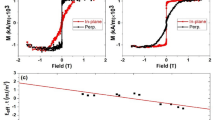Abstract
The tunnel magnetoresistance (TMR) effect in magnetic tunnel junctions (MTJs)1,2 is the key to developing magnetoresistive random-access-memory (MRAM), magnetic sensors and novel programmable logic devices3,4,5. Conventional MTJs with an amorphous aluminium oxide tunnel barrier, which have been extensively studied for device applications, exhibit a magnetoresistance ratio up to 70% at room temperature6. This low magnetoresistance seriously limits the feasibility of spintronics devices. Here, we report a giant MR ratio up to 180% at room temperature in single-crystal Fe/MgO/Fe MTJs. The origin of this enormous TMR effect is coherent spin-polarized tunnelling, where the symmetry of electron wave functions plays an important role. Moreover, we observed that their tunnel magnetoresistance oscillates as a function of tunnel barrier thickness, indicating that coherency of wave functions is conserved across the tunnel barrier. The coherent TMR effect is a key to making spintronic devices with novel quantum-mechanical functions, and to developing gigabit-scale MRAM.
This is a preview of subscription content, access via your institution
Access options
Subscribe to this journal
Receive 12 print issues and online access
$259.00 per year
only $21.58 per issue
Buy this article
- Purchase on Springer Link
- Instant access to full article PDF
Prices may be subject to local taxes which are calculated during checkout



Similar content being viewed by others
References
Moodera, J. S. et al. Large magnetoresistance at room temperature in ferromagnetic thin film tunnel junctions. Phys. Rev. Lett. 74, 3273–3276 (1995).
Miyazaki, T. & Tezuka, N. Giant magnetic tunneling effect in Fe/Al2O3/Fe junction. J. Magn. Magn. Mater. 139, L231–234 (1995).
Wolf, S. A. et al. Spintronics: A spin-based electronics vision for the future. Science 294, 1488–1495 (2001).
Ney, A. Pampuch, C., Koch, R. & Ploog, K. H. Programmable computing with a single magnetoresistive element. Nature 425, 485–487 (2003).
Moodera, J. S. & LeClair, P. A quantum leap. Nature Mater. 2, 707–708 (2003).
Wang, D., Nordman, C., Daughton, J. M., Qian, Z. & Fink, J. 70% TMR at room temperature for SDT sandwich junctions with CoFeB as free and reference layers. IEEE Trans. Magn. 40, 2269–2271 (2004).
Butler, W. H., Zhang X. -G., Schulthess, T. C. & Maclaren, J. M. Spin-dependent tunneling conductance of Fe/MgO/Fe sandwiches. Phys. Rev. B 63, 054416 (2001).
Mathon, J. & Umerski, A. Theory of tunneling magnetoresistance of an epitaxial Fe/MgO/Fe(001) junction. Phys. Rev. B 63, 220403R (2001).
Wulfhekel, W. et al. Single-crystal magnetotunnel junctions. Appl. Phys. Lett. 78, 509–511 (2001).
Bowen, M. et al. Large magnetoresistance in Fe/MgO/FeCo(001) epitaxial tunnel junctions on GaAs(001). Appl. Phys. Lett. 79, 1655–1657 (2001).
Faure-Vincent, J. et al. High tunnel magnetoresistance in epitaxial Fe/MgO/Fe tunnel junctions. Appl. Phys. Lett. 82, 4507–4509 (2003).
Mitani, S., Moriyama, T. & Takanashi, K. Fe/MgO/FeCo(100) epitaxial magnetic tunnel junctions prepared by using in situ plasma oxidation. J. Appl. Phys. 93, 8041–8043 (2003).
Yuasa, S., Fukushima, A., Nagahama, T., Ando, K. & Suzuki, Y. High tunnel magnetoresistance at room temperature in fully epitaxial Fe/MgO/Fe tunnel junctions due to coherent spin-polarized tunneling. Jpn J. Appl. Phys. 43, L588–L590 (2004).
Yuasa, S. et al. Magnetic tunnel junctions with single-crystal electrodes: a crystal anisotropy of tunnel magneto-resistance. Europhys. Lett. 52, 344–350 (2000).
Simmons, J. G. Electric tunnel effect between dissimilar electrodes separated by a thin insulating film. J. Appl. Phys. 34, 2581–2590 (1963).
Gibson, A. & Haydock, R. Stability of vacancy defects in MgO: The role of charge neutrality. Phys. Rev. B 50, 2582–2592 (1994).
Saito, Y. et al. Correlation between barrier width, barrier height, and dc bias voltage dependences on the magnetoresistance ratio in Ir-Mn exchange biased single and double tunnel junctions. Jpn J. Appl. Phys. 39, L1035–L1038 (2000).
Vassent, J. L., Dynna, M., Marty, A., Gilles, B. & Patrat, G. A study on growth and the relaxation of elastic strain in MgO on Fe(001). J. Appl. Phys. 80, 5727–5735 (1996).
You, C. Y. & Bader, S. D. Prediction of switching/rotation of the magnetization direction with applied voltage in a controllable interlayer exchange coupled system. J. Magn. Magn. Mater. 195, 488–500 (1999).
Yu, J. H., Lee, H. M., Ando, Y. & Miyazaki, T. Electron transport properties in magnetic tunnel junctions with epitaxial NiFe (111) ferromagnetic bottom electrodes. Appl. Phys. Lett. 82, 4735–4737 (2003).
Inaba, N. & Futamoto, M. Magnetic and crystallographic properties of Co-Cr-Pt longitudinal media prepared on MgO seedlayers deposited by ECR sputtering. IEEE Trans. Magn. 36, 2372–2374 (2000).
Yuasa, S., Nagahama, T. & Suzuki, Y. spin-polarized resonant tunneling in magnetic tunnel junctions. Science 297, 234–237 (2002).
Acknowledgements
We would like to thank M. Yamamoto, T. Katayama and Y. Yokoyama for their assistance with the experiments, and C. M. Boubeta, E. Tamura and H. Itoh for their helpful discussions.
Author information
Authors and Affiliations
Corresponding author
Ethics declarations
Competing interests
The authors declare no competing financial interests.
Supplementary information
Supplementary Information, Fig. S1
Supplementary Information, Fig. S2 (PDF 191 kb)
Rights and permissions
About this article
Cite this article
Yuasa, S., Nagahama, T., Fukushima, A. et al. Giant room-temperature magnetoresistance in single-crystal Fe/MgO/Fe magnetic tunnel junctions. Nature Mater 3, 868–871 (2004). https://doi.org/10.1038/nmat1257
Received:
Accepted:
Published:
Issue Date:
DOI: https://doi.org/10.1038/nmat1257
This article is cited by
-
Observation of Josephson harmonics in tunnel junctions
Nature Physics (2024)
-
Controlling the helicity of light by electrical magnetization switching
Nature (2024)
-
Electrical manipulation and detection of antiferromagnetism in magnetic tunnel junctions
Nature Electronics (2023)
-
Electrically tunable magnetic fluctuations in multilayered vanadium-doped tungsten diselenide
Nature Electronics (2023)
-
Room-temperature magnetoresistance in an all-antiferromagnetic tunnel junction
Nature (2023)



